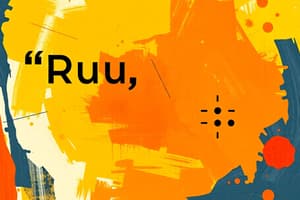Podcast
Questions and Answers
A historian is evaluating two primary source accounts of the same event. Which approach would most effectively reveal potential biases and reliability issues within each account?
A historian is evaluating two primary source accounts of the same event. Which approach would most effectively reveal potential biases and reliability issues within each account?
- Focusing solely on the authors' personal opinions expressed outside of the accounts.
- Comparing and contrasting the accounts, analyzing the authors' backgrounds, and checking for internal consistency and corroboration with other sources. (correct)
- Accepting both accounts as equally valid and reliable, regardless of any discrepancies or conflicting information.
- Ignoring contradictory information and focusing on corroborating details between the accounts.
While reading a scientific article, you encounter a graph displaying experimental results. What is the most effective strategy to understand the information conveyed by the graphic?
While reading a scientific article, you encounter a graph displaying experimental results. What is the most effective strategy to understand the information conveyed by the graphic?
- Examining the title, labels, axes, and units of measurement, and relating the graphic to the surrounding text. (correct)
- Ignoring the graphic and focusing solely on the text of the article.
- Assuming the graphic confirms your pre-existing beliefs about the topic.
- Skimming the graphic without reading the title, labels, or caption.
In an argumentative essay, which element is most crucial for establishing a strong and convincing argument?
In an argumentative essay, which element is most crucial for establishing a strong and convincing argument?
- Avoiding any citation of sources to appear more original.
- Using emotionally charged language and personal anecdotes.
- Relying solely on opinions and unsubstantiated claims.
- Presenting a clear thesis statement supported by logical reasoning, credible evidence, and acknowledging counterarguments. (correct)
When evaluating the structure of a persuasive speech, what aspect primarily determines its effectiveness in convincing the audience?
When evaluating the structure of a persuasive speech, what aspect primarily determines its effectiveness in convincing the audience?
A journalist is writing an article about a controversial new policy. Which approach best demonstrates responsible and unbiased reporting?
A journalist is writing an article about a controversial new policy. Which approach best demonstrates responsible and unbiased reporting?
Flashcards
Quoting from a Text
Quoting from a Text
Repeating exact words from a source to support ideas.
Applying Information
Applying Information
Using knowledge from a source in a new context or situation.
Analyzing Events and Ideas
Analyzing Events and Ideas
Breaking down events or concepts to understand their components.
Comparing and Contrasting Accounts
Comparing and Contrasting Accounts
Signup and view all the flashcards
Role of Graphics in a Text
Role of Graphics in a Text
Signup and view all the flashcards
Study Notes
Quoting from a Text
- Accurate quotation requires precise reproduction of the original text, including spelling, punctuation, and capitalization.
- Use quotation marks to enclose quoted material.
- A complete quotation should include all relevant parts of the original sentence or passage.
- Short quotations (usually fewer than four typed lines) are typically incorporated directly into the sentence.
- Long quotations (four or more lines) are usually set off from the text with indentation and no quotation marks.
- Always cite the source of the quotation correctly, including author, title, and page number (if applicable).
- Paraphrasing involves restating the author's ideas in your own words while maintaining the original meaning.
- Summarization condenses the author's main points into a shorter version, highlighting the essence of the argument.
Applying Information
- Apply information from a text by using the concepts, facts, and ideas from the source in your own work.
- Connecting learned ideas to new scenarios or situations is essential for understanding and remembering.
- This involves more than simply recalling information; it includes analyzing and applying the information in a meaningful way.
- Examples of applying information include: solving problems using the presented data, explaining concepts based on the text, or relating ideas from a text to personal experiences.
- Accurate application depends on correct comprehension and understanding of the source material.
Structure and Meaning
- Analyzing the structure of a text helps to understand how the author organizes ideas and builds an argument.
- Common text structures include chronological order, cause-and-effect relationships, problem-solution formats, compare-and-contrast, and classification.
- Identifying the main idea(s) of the text is crucial for understanding the author's purpose.
- Supporting details and evidence reinforce the main idea, providing specific information to support the author's claims.
- Recognizing the relationship between the different parts and how they create meaning for the whole is important.
Checking Reasoning and Support
- Critical analysis involves evaluating the reasoning used by the author and judging the strength of the evidence presented.
- Assess whether the author's reasoning is logical and supported by sufficient evidence.
- Look for biases or assumptions that might influence the author's conclusions.
- Identify logical fallacies in the reasoning, such as generalizations or faulty cause-and-effect connections.
- Evaluate the quality and sufficiency of the evidence in support of the author's claims.
Analyzing Events and Ideas
- This involves breaking down complex events or ideas into their component parts, examining how they are related, and identifying underlying causes, motivations, and consequences.
- Careful examination of events and historical contexts is important.
- Understanding the author's perspective and identifying significant details can provide insight.
- Using evidence presented in a text to understand an event or idea is crucial for a comprehensive analysis.
- Consider motivations and impacts of events/ideas.
Comparing and Contrasting Accounts
- Identifying similarities and differences between different accounts or perspectives on an event or issue.
- This strengthens understanding and creates nuanced views.
- Analyzing differences in accounts helps evaluate reliability and potential bias.
- Recognizing shared viewpoints can also highlight common threads and themes.
- This technique involves understanding multiple viewpoints and using evidence to assess information.
Seeing the Role of Graphics in a Text
- Graphics are often used to visually represent information and concepts.
- Charts, graphs, diagrams, and images can simplify complex information and make it easier to understand.
- Understanding the particular methods and techniques used to represent data can convey information to the reader.
- Evaluating graphics helps one determine if the graphic aids or hinders comprehension.
- Understanding which information a graphic is meant to convey is crucial for critical analysis.
Studying That Suits You
Use AI to generate personalized quizzes and flashcards to suit your learning preferences.




